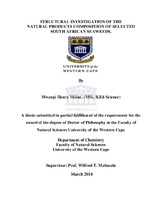| dc.description.abstract | Recently, a great deal of interest has developed towards the isolation of bioactive compounds from marine sources due to their numerous health benefits. Furthermore, marine algae are valuable sources of structurally diverse metabolites with scientifically proven therapeutic claims. The cell walls are rich in sulfated polysaccharides such as fucoidans in brown algae,
carrageenans in red algae and ulvans in green algae. These sulfated polysaccharides exhibit many beneficial biological activities such as anticoagulant, antiviral, antioxidative, anticancer and immunomodulating activities. They have great potential for further development as products in
cosmeceutical, pharmaceutical and nutraceutical areas. Although the mechanism of action is still not clear, their biological activities could be mainly attributed to their major secondary metabolites namely; phlorotannins, terpenoids and fucoidans. There was use of comprehensive chromatographic separations and a full analysis of isolates using one or other of the spectroscopic techniques. Antioxidant and cytotoxicity tests were perfomed in details for Ecklonia maxima. Furthermore, structural and electronic features of the phlorotannins were compared in an attempt to provide an explanation for the differences in their radical scavenging properties. In this regard, two main radical scavenging mechanisms, hydrogen atom transfer (HAT) and electron transfer (ET), were assessed in order to determine the preferred mode of radical scavenging. Fully relaxed geometry optimizations of the neutral and the radical species were performed utilizing DFT/B3LYP and DFT/UB3LYP methods respectively. In further studies, the structural and functional properties of sulfated polysaccharides from the three brown and one red seaweeds were
investigated. This was through detailed analysis of chemical composition of crude and purified polysaccharides using PMP - derivatization of hydrolysed sugars, anion exchange, molecular weight determination, ion chromatography , FT-IR, NMR to methylation analysis. The work reports isolation and characterization of compounds from four algae: Ecklonia maxima, phlorotannin derivatives, namely phloroglucinol (22), eckol (23), 7-phloroeckol (24), 2-phloroeckol (25) and a sterol, 24-ethylidine cholesterol (26); Splachinidium rugosum, 24-ethylidine cholesterol (
26), 1, 3-Dicapryloyl-2-oleoylglycerol (27), E-3,7,11,15-tetramethylhexa dec-2-en-1-ol (phytol) (2
8); Macrocystis angustifolia, 24-ethylidine cholesterol (26); a red seaweed Aeodes orbitosa, and E
-3, 7, 11, 15-tetramethylhexad ec-2-en-1-ol (28) and 17-(5-Ethyl-6-methylheptan-2-yl)-10,13-dimethyl-2,3,4,7, 8,9,11,12,14,15,16,17-dodecahydro-1 H-cyclopenta[a]phenanthren-3-ol (β-sitosterol) (29). Experimental findings and theoretical predictions of phlorotannins indicated that the radical scavenging activities followed the order 22< 23 < 25 < 24. Theoretical studies further indicated the ET mechanism is more significant than the HAT mechanism due to the high BDE values. Their polysaccharide structures were tentatively shown to have a backbone of (1-3) and (1-4) linkages with sulfate groups at O-2 and O-2, 3 positions. The only red algae studied contained, 2-O-methyl-D-galactose with (1-3) and (1-4)-glycosidic linkages possessing sulfate groups at positions 2 and 6. | en_US |

